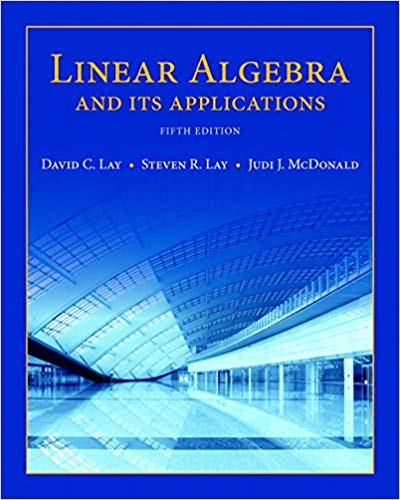
Linear Algebra and Its Applications, 5th Edition
Authors: David C. Lay, Steven R. Lay, Judi J. McDonald
ISBN-13: 978-0321982384
We have solutions for your book!
See our solution for Question 23E from Chapter 1.9 from Lay's Linear Algebra and Its Applications, 5th Edition.
Problem 23E
Chapter:
Problem:
In Exercises 23 and 24, mark each statement True or False. Justify each answer. a. A linear transformation T : ℝn → ℝm is completely determined by its effect on the columns of the n × n identity matrix. b. If T : ℝ2 → ℝ2 rotates vectors about the origin through an angle φ, then T is a linear transformation. c. When two linear transformations are performed one after another, the combined effect may not always be a linear transformation. d. A mapping T : ℝn → ℝm is onto ℝm if every vector x in ℝn maps onto some vector in ℝm. e. If A is a 3 × 2 matrix, then the transformation x ↦ Ax cannot be one-to-one.
Step-by-Step Solution
Given Information
We are given with some statements that we have to find whether they are True or False
Step-1: (a)
Any vector can be written as a combination of columns of the Identity matrix. So, let a vector $x$ is given by \[\begin{array}{l} {\bf{x}} = {I_n}{\bf{x}}\\ {\bf{x}} = \left[ {{{\bf{e}}_1}{{\bf{e}}_2} \cdots {{\bf{e}}_n}} \right]\left[ {\begin{array}{*{20}{c}} {{x_1}}\\ {{x_2}}\\ {{x_n}} \end{array}} \right]\\ {\bf{x}} = {x_1}{{\bf{e}}_1} + {x_2}{{\bf{e}}_2} + \cdots + {x_n}{{\bf{e}}_n} \end{array}\] If apply transformation to vector x \[\begin{array}{l} T({\bf{x}}) = T\left( {{x_1}{{\bf{e}}_1} + {x_2}{{\bf{e}}_2} + \cdots + {x_n}{{\bf{e}}_n}} \right)\\ T({\bf{x}}) = {x_1}T\left( {{{\bf{e}}_1}} \right) + {x_1}T\left( {{{\bf{e}}_1}} \right) + \cdots + {x_1}T\left( {{{\bf{e}}_1}} \right) \end{array}\]
The statement is True
Step-2: (b)
The standard matrix that rotates vectors about the origin through an angle $\varphi $ is given by: \[A = \left[ {\begin{array}{*{20}{c}} {\cos \varphi }&{ - \sin \varphi }\\ {\sin \varphi }&{\cos \varphi } \end{array}} \right]\] Since every matrix transformation is a linear transformation, the given transformation is also a linear transformation
The statement is True
Step-3: (c)
As quoted in "Geometric Linear Transformations", a composition of two linear transformations is again a linear transformation,
The statement is False
Step-4: (d)
A mapping $T:{R^n} \to {R^m}$ is said to be onto $R^m$ if each b in $R^m$ is the image of at least one x in $R^n$.
The statement is False
Step-5: (e)
Consider an example of matrix and its echelon form: \[A = \left[ {\begin{array}{*{20}{c}} 2&{ - 4}\\ 5&7\\ 4&1 \end{array}} \right] \approx \left[ {\begin{array}{*{20}{l}} 1&0\\ 0&1\\ 0&0 \end{array}} \right]\] We cans see that the matrix A has pivots in all columns, hence there are no free variables. Therefore, the columns of A are linearly independent; it implies that the transformation T is one-to-one.
The statement is False
We are given with some statements that we have to find whether they are True or False
Step-1: (a)
Any vector can be written as a combination of columns of the Identity matrix. So, let a vector $x$ is given by \[\begin{array}{l} {\bf{x}} = {I_n}{\bf{x}}\\ {\bf{x}} = \left[ {{{\bf{e}}_1}{{\bf{e}}_2} \cdots {{\bf{e}}_n}} \right]\left[ {\begin{array}{*{20}{c}} {{x_1}}\\ {{x_2}}\\ {{x_n}} \end{array}} \right]\\ {\bf{x}} = {x_1}{{\bf{e}}_1} + {x_2}{{\bf{e}}_2} + \cdots + {x_n}{{\bf{e}}_n} \end{array}\] If apply transformation to vector x \[\begin{array}{l} T({\bf{x}}) = T\left( {{x_1}{{\bf{e}}_1} + {x_2}{{\bf{e}}_2} + \cdots + {x_n}{{\bf{e}}_n}} \right)\\ T({\bf{x}}) = {x_1}T\left( {{{\bf{e}}_1}} \right) + {x_1}T\left( {{{\bf{e}}_1}} \right) + \cdots + {x_1}T\left( {{{\bf{e}}_1}} \right) \end{array}\]
The statement is True
Step-2: (b)
The standard matrix that rotates vectors about the origin through an angle $\varphi $ is given by: \[A = \left[ {\begin{array}{*{20}{c}} {\cos \varphi }&{ - \sin \varphi }\\ {\sin \varphi }&{\cos \varphi } \end{array}} \right]\] Since every matrix transformation is a linear transformation, the given transformation is also a linear transformation
The statement is True
Step-3: (c)
As quoted in "Geometric Linear Transformations", a composition of two linear transformations is again a linear transformation,
The statement is False
Step-4: (d)
A mapping $T:{R^n} \to {R^m}$ is said to be onto $R^m$ if each b in $R^m$ is the image of at least one x in $R^n$.
The statement is False
Step-5: (e)
Consider an example of matrix and its echelon form: \[A = \left[ {\begin{array}{*{20}{c}} 2&{ - 4}\\ 5&7\\ 4&1 \end{array}} \right] \approx \left[ {\begin{array}{*{20}{l}} 1&0\\ 0&1\\ 0&0 \end{array}} \right]\] We cans see that the matrix A has pivots in all columns, hence there are no free variables. Therefore, the columns of A are linearly independent; it implies that the transformation T is one-to-one.
The statement is False